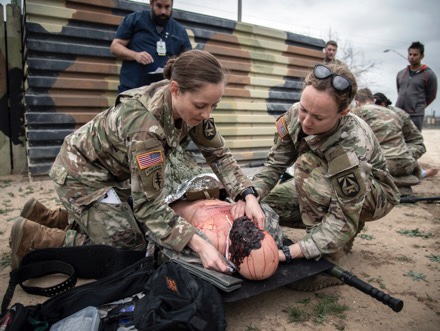JOINT BASE SAN ANTONIO-FORT SAM HOUSTON, Texas (AFNS) —
Army and Air Force personnel from Brooke Army Medical Center’s Department of Emergency Medicine recently established a simulation training platform to increase readiness and meet Joint Commission requirements for staff development and training.

The Tactical Trauma Reaction and Evacuation Crossover Course, or TTREX, is designed to test and validate Individual Critical Task Lists and the Comprehensive Medical Readiness Program for military medical personnel.
“The TTREX course was developed to familiarize military and civilian personnel with critical trauma skills relevant to both the hospital and the austere environment and to maintain mission readiness,” said Army 1st Lt. Jackson Goddard, registered nurse.
The eight-hour course at the Torch Training Site at Joint Base San Antonio-Lackland incorporates battlefield trauma simulations, evacuation procedures, and trauma care in a Role 2 environment. Role 2, also known as forward resuscitative care, has the capability to manage more advanced trauma patients and continue more advanced resuscitative measures in an austere environment such as a combat support hospital.
“We have combined the point of injury with the Role 2 environment,” said Air Force 1st Lt. Marissa Vasek, registered nurse. “Our goal is to get people to understand the deployment setting and the challenges they might face while deployed including limitations with supplies, manpower or experience.”
Additionally, participants experience what it’s like to be on a C-130 Hercules military transport aircraft during a critical care air transport mission to see how a patient is transported to a higher echelon of care.
Army Spc. Wade Wolf, a combat medic, said he feels the training is beneficial because participants get to see how a patient moves from the point of injury to a stateside hospital.
“We’ve had more than 40 participants over the two-day exercise,” Wolf said. “I would say about half of them have never been deployed.”
Emergency nurse Army Capt. Megan Gross agreed.

“This has been one of my favorite courses I have attended in my 14 years in the military,” Gross said. “The course allows nurses and medics to test their trauma knowledge in a tactical environment and provides a realistic peek into the deployed setting. The teamwork and camaraderie among the attendees and the instructors are unique and foster a real esprit de corps.
“My favorite part was the Role 2 trauma lane and having the opportunity to work in a small team to assess, perform interventions, and prepare our patient for transport,” she added. “The autonomy aspect provided a unique learning opportunity we often do not get in the hospital setting. The instructors provided a learning environment that was challenging but collaborative at the same time. I loved it!”
The TTREX course will be offered quarterly and is open to service members, civilians, and contractors.
“The course is geared to medics and nurses, but it’s open to anyone who’s willing to learn or just wants to observe,” Vasek said. “We have even had a few physicians come through.”
“A part of creating this exercise was to help military nurses and medics gain the confidence they need to perform under high stress while downrange,” added Army Capt. Brianna Barkley, a registered nurse who helped create the course. “We have seen camaraderie built amongst BAMC teammates while also checking off required readiness skills. What made our exercise successful is the fact that it is a learning environment. Participants feel comfortable making mistakes and learning from those mistakes to build confidence during deployments.”
“This training is invaluable because it allows service members to maintain combat readiness,” Gross said. “We have Individual Critical Task Lists, which are required training tasks for our jobs. This training opportunity allowed me to complete all of my ICTLS for the year, which maintains my individual combat readiness.”
“I was so impressed with this course as a participant that I volunteered to become an instructor and look forward to being a part of the next TTREX course,” she added.
By Lori Newman, Brooke Army Medical Center Public Affairs
Army photos by Jason W. Edwards


Where is their PPE?? Train how you fight???
Nice “woke” new schools! Utterly pathetic
WTF? You’re pathetic. What is woke about this course? It’s about teaching medical personnel how to perform Role 2 interventions closer to the point of injury. These interventions don’t occur on the X. They also don’t change much when wearing PPE. Not to mention, this will likely be happening at a forward, yet secure, environment where PPE may not be required.
Do you even know enough about this subject to be whining about it or are you just spazzing out because someone on the tv told you to?
Jake, I think he means medical PPE like gloves and protective eye wear for blood borne pathogens.
Admittedly, all I saw at first glance was sunglasses on the top of someone’s head. The SGM reminded me once long ago that that wasn’t acceptable and I guess it worked since I remember it to this day.
Lol, calls me a spazz whilst “spazzing” out himself! Lol
BLS certified Ocean Lifeguard 1996 – 2006, Cert. First Responder 1997, EMT-B (FL) 1998 – 2006, TCCC, US Navy, 2008, 2012, 2013.
Funny how “woke” just sent you over the edge!
First pic, no PPE, i.e latex or non-latex gloves nor only for the “first responders” protection but to not infect the patient as well! Yes, no eye-pro, I dont care, sunglasses are better than nothing!
……and why do you assume I watch tv? who is telling people to “spazz” out?